
This morning’s key headlines from GenerationalDynamics.com
- The Ebola endgame
- Updating the Global Conflict Risk Assessment for Ebola
- The World Health Organization (WHO)
- Ebola in West Africa
- Ebola in megacities and dense slums
- Ebola in war zones
The Ebola endgame
Today, the biggest threat to US security by far is China, which ispreparing as rapidly as possible for a preemptive massive missileattack on American cities, aircraft carriers, and militaryinstallations. There are also terrorist threats to the U.S., but whatwe now call terrorism will simply dissolve and be subsumed into WorldWar III. For example, the Islamic State “terrorist” group will join with theSunni component of the coming sectarian Sunni vs Shia war in theMideast, while the Hezbollah “terrorist” group will join the Shiacomponent. The Shia component will be allied with Iran, Russia andIndia, while the Sunni component will be allied with Pakistan andChina. In that sense, what we now call terrorism is really just aside show to what will be a number of regional and global existentialwars over the next 10-15 years. There’s no guarantee that the UnitedStates will survive.
The above Generational Dynamics assessment, or something like it,might have been written at any time in the last few years.
But now there’s major new factor that has to be considered: The Ebolapandemic. It’s now clear that Ebola will play an important role inthe world in the next few years, and will change the course ofhistory. Ebola will spread in Africa beyond West Africa. It willspread first into war zones, such as Syria, and it will spread intodensely packed slums in megacities. For that reason, it will be a bigpart of any coming world war. I fully expect Ebola to have spreadaround the world by 2030, killing hundreds of millions of people.
Updating the Global Conflict Risk Assessment for Ebola
In 2004, I identified “the six most dangerous regions in world” based on a Generational Dynamicsanalysis. My conclusion at the time was that a new world war would bestarted by a regional war in one of those six regions, or by a globalfinancial crisis or by a global bird flu pandemic.
I incorporated those six region/items in a “Global Conflict RiskAssessment” graphic that I began posting on the Home Page of my web site.Its purpose was to encapsulate the current state of the world, andthe likelihood of world conflict. The intention was that the graphicwould be updated only rarely, as world events require. The originalgraphic, posted on October 1, 2004 was:
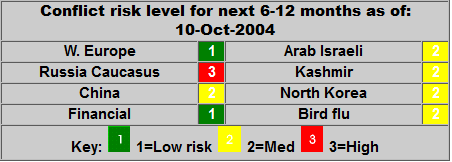
Global Conflict Risk Graphic – October 1, 2004
Note that in 2004, I considered the most dangerous of all to be theRussian Caucasus, because of the recent Beslan massacre and because… wait for it! … Russia’s president Vladimir Putin was showingextreme belligerence toward Ukraine. That was ten years ago. Plusça change, plus c’est la même chose.There have been seven changes in the ten years since then, the lastone on January 1, 2013:
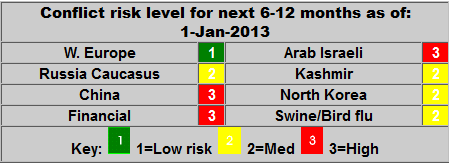
Global Conflict Risk Graphic – January 1, 2013
If you’d like to review all the Conflict Risk Graphics inchronological order, along with brief explanations of why each risklevel was assigned, see Global Conflict Risk Graphics.
Today, I’m updating the graphic for the first time since thebeginning of 2013. The updated graphic is as follows:
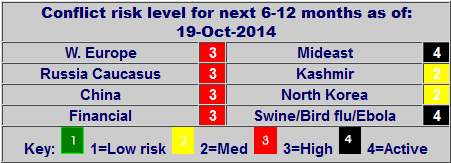
Global Conflict Risk Graphic – October 19, 2014
The two most significant changes is that two items have crossed over from
- Mideast: The “Arab Awakening” has so thoroughly destabilized the Mideast that, in my view, the Syria/Iraq and Yemen wars will be not be settled before the spiral into a larger regional war. This is in contrast to the five previous Mideast wars: the war between Israelis and Hezbollah, fought largely on Lebanon’s soil in 2006; the war between Palestinian factions Hamas and Fatah in Gaza in 2008, that led to Hamas control of Gaza; Operation Cast Lead, the war between Israel and Hamas in Gaza early in 2009; the two wars between Israel and Hamas in Gaza in November, 2012 and July-August 2014. Those wars could be settled with a ceasefire, but in my view, no ceasefire is possible in the Syria/Iraq and Yemen wars anymore.
- Ebola: It’s now clear that Ebola will not be controlled, and will play a significant role in the world’s future. I’ll be discussing this issue at length below.
The World Health Organization (WHO)
The World Health Organization (WHO) has been under a great deal ofcriticism from politicians trying to deflect the blame from their ownfailings. One common criticism is that WHO did not react quicklyenough after the first Ebola outbreak in Guinea, and didn’t evenrealize the severity of the problem. In fact, WHO has conducted itsown internal investigation, and found that “it botched attempts tostop the Ebola outbreak in West Africa, blaming factors includingincompetent staff and a lack of information,” and that they shouldhave realized that “traditional infectious disease containment methodswouldn’t work in a region with porous borders and broken healthsystems,” according to the AP.
In fact, the Ebola crisis is the moment that the World HealthOrganization was created for. It was created by the survivors ofWorld War II — and it was also created by the survivors of the 1918Spanish Flu epidemic that killed tens of millions of people. The WHOshould have reacted immediately on the Ebola breakout, and doneeverything possible to make sure that the mistakes of 1918 would notbe repeated.
But anyone who understands generational theory knows that that’s nothow the world works. The survivors of a crisis, any crisis, spendtheir lives implementing institutions and measures to guarantee thatthe same crisis will not happen again. But once those survivors aregone, the generations of survivors that come after will simply believethat no such thing, in this case something like the 1918 epidemic,could ever happen again, because we’re all smarter now, so thoseold-fashioned crises are no longer possible.
The critical generational event occurred in 1976, 58 years after the1918 epidemic, when the “swine flu” panic occurred. The public becamehysterical over the possibility of a new flu pandemic. Responding topublic demands, the government prepared millions of doses of swine fluvaccine. The pandemic amounted to nothing, and the whole thing was apolitical fiasco.
The 1976 swine flu fiasco served the purpose of discrediting anyonewho worried about a new epidemic. This generational change inattitude continues today, and explains why WHO “botched” the Ebolainvestigation. (For further discussion of the 58-year hypothesis, see “The Iraq war may be related to the bombing of Hiroshima and Nagasaki.” from 2008.)
Ebola in West Africa
In fact, it’s not clear to me that WHO could have stopped the Ebolapandemic even if they had been sufficiently alarmed when it started.In the previous section, we quoted WHO as blaming itself for notrealizing that “traditional infectious disease containment methodswouldn’t work in a region with porous borders and broken healthsystems.” Those porous borders and broken health systems would havebeen the same whether WHO was alarmed or not.
There have been several outbreaks of Ebola, mostly in Zaire (nowrenamed to Congo). In those cases, the outbreaks were confined to afew small, remote villages, and the outbreaks were controlled byblocking travel into or out of the affected villages, and then lettingthe pandemic “burn itself out,” in the words of one analyst I heard.This means that everyone in the village became infected. Most peopledied, but the ones who survived could rebuild their villages and beimmune to Ebola for the rest of their lives.
Whether that kind of containment could have been accomplishedwhen it first broke out in Guinea is not known to me, but it’s certainlytrue that containment will not work now.
The mathematics of the published figures is irrefutable. There are10,000 infections now in West Africa, and the number of infectionsdoubles every 3-4 weeks. That means that there will be millions ofinfections by Summer or Fall 2015. And there’s nothing that can stopit from spreading beyond West Africa – Côte d’Ivoire is particularlyvulnerable.
Furthermore, 50-70% of those infected die. This means that within acouple of years or so, more than half the population of West Africawill die of Ebola. The same will be true of other countries thatthe spread of Ebola reaches.
What about a vaccine? I have not heard anyone say that a vaccine willbe available in less than a year or two in large quantities. Even ifa vaccine were available today, could it be administered to, say, thepopulation of Côte d’Ivoire in time to save it from the spread ofEbola? I would think not.
Ebola in megacities and dense slums
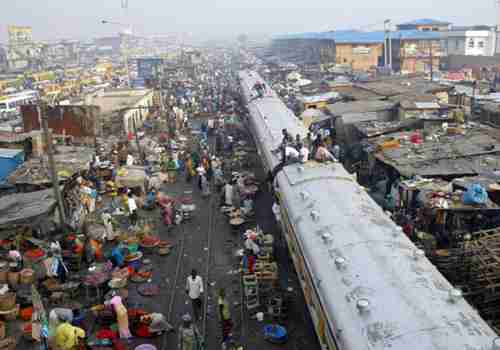
Lagos, Nigeria
Lagos has a fairly sophisticated health system. When an Ebola patientarrived by plane in Lagos in July, there was a swift reaction.Through contact tracing, officials located some 900 people who werepotentially exposed to the disease. There were finally 19 confirmedcases of Ebola and eight deaths, but the infection was stopped inNigeria.
Imagine, however, someone with Ebola arriving on the train picturedabove in Lagos, Nigeria, and visiting friends and family. Suppose heinfected a couple of other people, and before anyone realized what wasgoing on, people with whom he’d been in contact left town on the sametrain. This is not an unlikely scenario. How would that Ebolaoutbreak be contained?
Passengers aren’t identified on a train the way they are on a plane, so contact tracing would be impossible. If there were 900 peoplepotentially exposed, there would be no way to identify and find them,and they would go on infecting other people.
Once again, this is not an unlikely scenario. It’s fairly certain tohappen, and it’s fairly certain to continue happening.
Megacities are particularly vulnerable, because there is publictransportation and anonymity. The 20 largest megacities in the world,according to Demographia (PDF) are:
POPULATIONS OF WORLD'S 20 LARGEST MEGACITIES-------------------------------------------------------' 1 ' Tokyo-Yokohama, Japan ' 37,555,000 '' 2 ' Jakarta (Jabotabek), Indonesia ' 29,959,000 '' 3 ' Delhi, DL-HR-UP, India ' 24,134,000 '' 4 ' Seoul-Incheon, South Korea ' 22,992,000 '' 5 ' Manila, Philippines ' 22,710,000 '' 6 ' Shanghai, SHG-ZJ-JS, China ' 22,650,000 '' 7 ' Karachi, Pakistan ' 21,585,000 '' 8 ' New York, NY-NJ-CT, United States' 20,661,000 '' 9 ' Mexico City, Mexico ' 20,300,000 '' 10 ' Sao Paulo, Brazil ' 20,273,000 '' 11 ' Beijing, BJ, China ' 19,277,000 '' 12 ' Guangzhou-Foshan, GD, China ' 18,316,000 '' 13 ' Mumbai, MAH, India ' 17,672,000 '' 14 ' Osaka-Kobe-Kyoto, Japan ' 17,234,000 '' 15 ' Moscow, Russia ' 15,885,000 '' 16 ' Los Angeles, CA, United States ' 15,250,000 '' 17 ' Cairo, Egypt ' 15,206,000 '' 18 ' Bangkok, Thailand ' 14,910,000 '' 19 ' Kolkota, WB, India ' 14,896,000 '' 20 ' Dhaka, Bangladesh ' 14,816,000 '-------------------------------------------------------
However, what may be more important than total population ispopulation density. The following table lists the most denselypopulated cities in the world, with a few United States cities addedto the end of the table:
#PEOPLE/SQ MILE IN WORLD'S MOST DENSELY POPULATED CITIES------------------------------------------------------------' 1 ' Dhaka, Bangladesh ' 44,000 '' 2 ' Hyderabad, Pakistan ' 40,700 '' 3 ' Mumbai, MAH, India ' 32,300 '' 4 ' Kalyan, MAH, India ' 30,300 '' 5 ' Chittagong, Bangladesh ' 28,400 '' 6 ' Vijayawada. AP, India ' 27,900 '' 7 ' Hong Kong, China: Hong Kong SAR ' 25,700 '' 8 ' Malegaon, HAM, India ' 24,700 '' 9 ' Macau, China: Macau SAR ' 23,700 '' 10 ' Aligarh, UP, India ' 23,500 '' 11 ' Karachi, Pakistan ' 22,800 '' 12 ' Ranchi, JHA, India ' 21,200 '' 13 ' Surat, GUJ, India ' 21,000 '' 14 ' Madurai, TN, India ' 20,700 '' 15 ' Gwalior, MP, India ' 20,700 '' 16 ' Asansol, WB, India ' 20,500 '' 17 ' Salem, TN, India ' 20,000 '' 18 ' Ahmedabad, GUJ, India ' 19,800 '' 18 ' Rajkot, GUJ, India ' 19,800 '' 20 ' Kathmandu, Nepal ' 19,400 '' 37 ' Kinshasa, Congo (Dem. Rep.) ' 16,700 '' 39 ' Bogota, Colombia ' 16,600 '' 40 ' Gaza, Palestine ' 16,500 '' 43 ' Alexandria, Egypt ' 15,600 '' 55 ' Kano, Nigeria ' 15,000 '' 81 ' Lagos, Nigeria ' 13,800 '' 209 ' Mexico City, Mexico ' 9,800 '' 564 ' Leicester, United Kingdom ' 4,700 '' 794 ' Los Angeles, CA, United States ' 2,400 '' 808 ' San Francisco-San Jose, CA, United States ' 2,100 '' 823 ' Honolulu, HI, United States ' 1,900 '' 823 ' Las Vegas, NV, United States ' 1,900 '' 829 ' Miami, FL, United States ' 1,800 '' 830 ' New York, NY-NJ-CT, United States ' 1,800 '------------------------------------------------------------
Of course, a city doesn’t have to be on either of these lists to bevulnerable. Even a small, densely populated neighborhood in anotherwise sparsely populated city could be vulnerable.
Megacities and densely populated citiesare going to be vulnerable to Ebola outbreaks, and many of theseoutbreaks will occur before it’s all over.
Ebola in war zones
There have been a small number of Ebola cases in the United States sofar, and what I’ve learned by watching them unfold is that controllingthem requires the following:
- Temperature screenings at airports, bus and train stations, seaports, or at any point of entry at any border.
- Patient isolation of those infected or suspects.
- Contact tracing — identifying and isolating anyone with whom an infected patient has had contact.
None of these things will be possible in a war zone, where healthservices will have broken down, and where health workers will bevulnerable to gunfire and bombs. That means that once even a smallEbola outbreak occurs in war zone, there will generally be no way tokeep it from spreading.
I’ve been writing for years about the coming Clash of Civilizationworld war where India, Russia and Iran will be our allies versusChina, Pakistan, and the Sunni Muslims. Now we have to add the “Ebolafactor,” which will interact with everything else going on in theworld. Ebola outbreaks will destabilize more regions of the world,leading to more wars, and war zones will be the perfect places whereEbola outbreaks can spread.
During the time of the Black Death plague of the 1340s, attackingarmies would use catapults to hurl dead soldiers over the walls ofwalled cities, so that the citizens of those cities would also die ofthe plague. Maybe in the next few years, we’ll be seeing some ofthose catapults again.
KEYS: Generational Dynamics, Ebola, World Health Organization, WHO,Global Conflict Risk Assessment, West Africa, China
Permanent web link to this article
Receive daily World View columns by e-mail
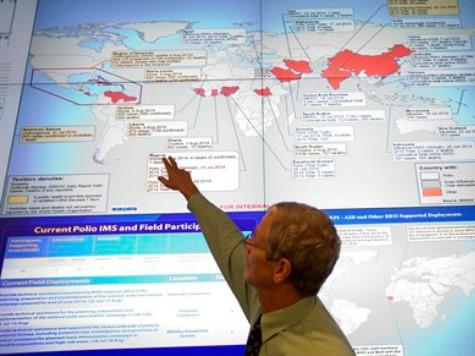
COMMENTS
Please let us know if you're having issues with commenting.